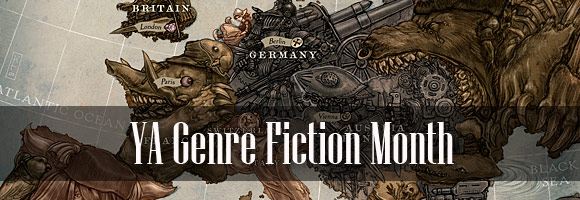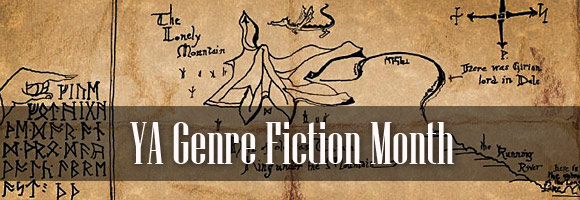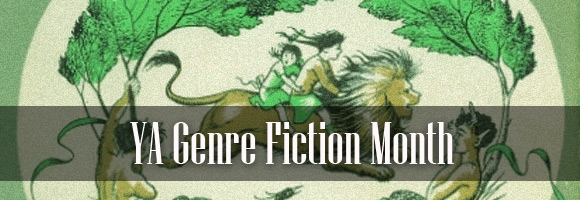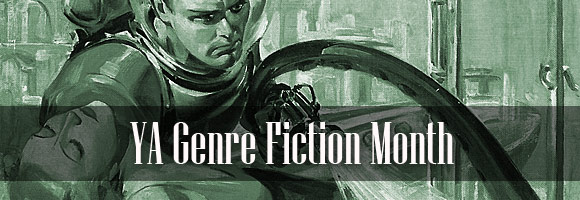YA Genre Fiction Month: Leviathan
Guest Blogger, Allie McCarn, reviews science fiction and fantasy books on her blog Tethyan Books which we featured in a previous post: Five SF/F Book Blogs Worth Reading. She has already contributed many great book reviews to WWEnd and has generously volunteered to write some periodic reviews for our blog. Be sure to check out her site and let her know you found her here.
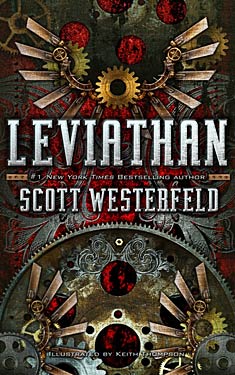 Leviathan by Scott Westerfeld
Leviathan by Scott Westerfeld
Published: Simon Pulse, 2009
Series: Leviathan Series: Book 1
Awards Won: Locus Young Adult Award 2010
The Book:
"It is the cusp of World War I. The Austro-Hungarians and Germans have their Clankers, steam-driven iron machines loaded with guns and ammunition. The British Darwinists employ genetically fabricated animals as their weaponry. Their Leviathan is a whale airship, and the most masterful beast in the British fleet.
Aleksandar Ferdinand, a Clanker, and Deryn Sharp, a Darwinist, are on opposite sides of the war. But their paths cross in the most unexpected way, taking them both aboard the Leviathan on a fantastical, around-the-world adventure…. One that will change both their lives forever." ~barnesandnoble.com
Scott Westerfeld is a well-known name in young adult fiction, though up until now I’d never read any of his work. In honor of WWEnd’s “Young Adult Genre Fiction” month, I’m reviewing his most recent series, which starts with Leviathan. Leviathan had a satisfying ending, to my mind, but it is clearly the first part of a larger story. The final volume of this series, Goliath, came out this past September, so I’m looking forward to being able to read the complete trilogy, uninterrupted!
My Thoughts:
Leviathan is a non-stop adventure that spans several European countries. While it takes place during the start of World War I, many aspects of Westerfeld’s world differ from reality. The most notable difference, of course, is the presence of fantastical technology. The Clankers have powerful, steam-powered walkers, and the Darwinists have amazing animals fabricated from the ‘life strings’ of many different species. These animals range from messenger lizards, to jellyfish-based airbeasts, to complicated floating ecosystems like the Leviathan airship of the book’s title. Westerfeld spends a lot of time describing his imaginative creations, and they are also brought to life by Keith Thompson’s many beautiful illustrations (like the example map in the header above).
While the technology is a major selling point of the story, Leviathan also features two engaging protagonists. Alek Ferdinand (yes, that Ferdinand) is an aristocratic Clanker fugitive with a huge secret. His parents made sure he was trained in mechaniks, swordfighting, and many languages, but he still has no idea how to deal with the world outside his family’s estate. Deryn Sharp has a pretty major secret of her own—she’s joined the British military as a midshipman, posing as a boy. Deryn mostly manages to keep everyone convinced of her gender through force of personality. Her never-ending exuberance and boyish swagger make it seem like her life has always been a jump from one adventure to the next. Deryn and Alek are opposites in many ways, though they are both fallible teenagers in the middle of very dangerous situations.
Though Deryn and Alek are exciting characters to follow, they seem to be written a little younger than their supposed age. If the book had not specified that they were fifteen, I would have estimated an age of twelve or thirteen. Even in the many illustrations, they appear to be shown as pre-teens, not teens. In general, I would say that is in line with the targeted demographic, which I would guess to be middle schoolers (about 12-14 years old). This guess is based on the reading level, the portrayal of the protagonists, and the amount of questionable content (very little, save for a few potentially frightening battle scenes). I don’t mean to say that someone older couldn’t enjoy it—I’m over a decade past that age group, and I still thought Leviathan was a lot of fun.
Aside from the constant thrills of the story, Leviathan is also concerned with portraying the interconnectedness of living systems. One example of this can be seen in the Leviathan airship itself. In addition to the hydrogen-filled whale-like creature that makes up its main body, the Leviathan’s life and health rely on an ecosystem made up of birds, bats, bees, bacteria, curious hydrogen-sniffing animals, and many others. If any one of the pieces of this system is missing, it will have disastrous effects on the whole.
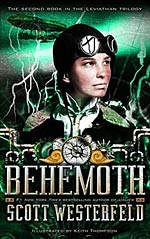 The Leviathan airship is also controlled by Captain Hobbes, which makes it a fairly clear reference to Thomas Hobbes’s famous work of the same name. Hobbes’s work is an early example of social contract theory, and it describes an ideal government as a kind of enormous, complex creature composed of its living members. The themes of interdependence and cooperation are also repeated in various ways through the political discussions and actions of the novel. While Leviathan is entertaining as an adventure story, there’s also plenty of discussion material for those who want to look beneath the surface.
The Leviathan airship is also controlled by Captain Hobbes, which makes it a fairly clear reference to Thomas Hobbes’s famous work of the same name. Hobbes’s work is an early example of social contract theory, and it describes an ideal government as a kind of enormous, complex creature composed of its living members. The themes of interdependence and cooperation are also repeated in various ways through the political discussions and actions of the novel. While Leviathan is entertaining as an adventure story, there’s also plenty of discussion material for those who want to look beneath the surface.
My Rating: 4/5
Leviathan is an exciting, action-packed steampunk re-imagining of World War I, with fantastic technology that is brought to life through Keith Thompson’s frequent illustrations. Though the protagonists, Alek and Deryn, seem younger than their fifteen years, they are engagingly intelligent and resourceful protagonists. Leviathan also contains a subtext about the interdependence of living systems and the necessity of cooperation, making it a book worth discussion. I’m starting Behemoth now, and I can’t wait to see what happens next!
Science Fiction for Young Adults: A Recommended List by David Brin
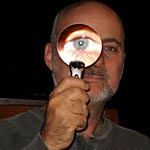 As part of our YA Genre Fiction Month on WWEnd we’ve added a new list of books for your reading pleasure:
As part of our YA Genre Fiction Month on WWEnd we’ve added a new list of books for your reading pleasure:
Science Fiction for Young Adults: A Recommended List by David Brin
Why post a YA list by David Brin? Well, he’s David Brin for crying out loud – which is reason enough for me. And it’s a really good list. But mainly it because Mr. Brin has been actively working to spread the gospel of SF/F to younger fans for many years. I’ll let him explain:
For two decades I’ve been involved in projects to help engage young readers with science fiction, from the AboutSF and Reading for the Future programs to my own WoW Prize and helping establish the Andre Nortion Nebula Award for Young Adult SF. After years replying to personal queries I finally compiled my own recommended reading lists for Young Adults as well as elementary and middle school kids. I hope they prove useful. Good sci fi correlates with vigor, creativity and success, not only for young readers, but for any civilization!
Bravo, Mr. Brin. Be sure to visit the author’s blog, Contrary Brin, to read the original post of the list which contains short intros and commentary for each of the books.
So what do you think of this list? Anything you would want to add or take out? How many of these have you read? Check your reading stats to see. I’ve only read 16 out of 89 but I’ve got a half dozen more on my reading list.
Philip K. Dickathon: We Can Build You
Guest Blogger and WWEnd Member, Charles Dee Mitchell, has contributed a great many book reviews to WWEnd and we’ve invited him to contribute to our blog. This is the latest in Dee’s series of Philip K. Dick reviews that he started on his blog www.potatoweather.blogspot.com. We’ll be posting one every week until he runs out of reviews or gets tired of Philip K. Dick books.
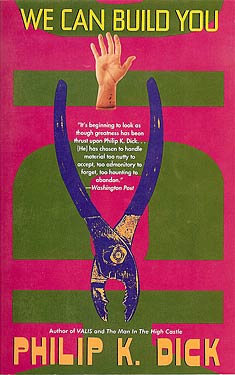 Philip K. Dick always said that he wrote with his fingers. For a decade or so he wrote with his fingers on speed. He would get an outline together, then sit himself at the typewriter and let it flow. He wrote We Can Build You in 1962, his annus mirabilis during which he completed 12 novels. This is the most "stream of conscious" novel of his that I have read. Not in the sense that he is creating characters who share their interior monologues. The interior monologue is all Phil’s, partially put into the mind of his first person narrator, but mostly spilling out in a direct current from his brain to his fingers to the page.
Philip K. Dick always said that he wrote with his fingers. For a decade or so he wrote with his fingers on speed. He would get an outline together, then sit himself at the typewriter and let it flow. He wrote We Can Build You in 1962, his annus mirabilis during which he completed 12 novels. This is the most "stream of conscious" novel of his that I have read. Not in the sense that he is creating characters who share their interior monologues. The interior monologue is all Phil’s, partially put into the mind of his first person narrator, but mostly spilling out in a direct current from his brain to his fingers to the page.
We Can Build You takes place in the distant future of the 1980’s. (PKD seldom bothered setting stories far enough into the future that any of the scientific marvels he works into his plots might be even vaguely possible.) Louis Rosen works for Maury Rock in a shady sales business. They run ads in small-town newspapers announcing the local repossession of a piano or electronic organ, and they are ready to make a deal if it saves shipping. They do pretty well, having survived one Better Business Bureau investigation, but business is drying up. Maury and his engineer have decided instead to go into the simulacra business, creating human simulacra so lifelike they easily pass as the real McCoy, or in this case the real Edwin M. Stanton, Abraham Lincoln’s Secretary of State. They have Lincoln himself in the works.
One quarter of the American population is schizophrenic and spends time in government-run facilities. A small number of citizens are radiation mutants — Louis’s younger brother has his face upside down on his head. Thomas C. Barrow is an entrepreneur who needs to unload some lunar real estate. Pris is a beautiful, recovering schizophrenic and Maury’s daughter. Louis’s love of Pris is driving him insane.
That’s about it. Scene after scene is outrageous but seldom very funny. Perhaps because the narrator is so driven, there is never any distance from the action. Take a scene where Louis is getting legal advice from Abraham Lincoln in a San Francisco nightclub while Earl Grant performs onstage. That’s funny when you think about it.
I can imagine some French critic has described We Can Build You as a meditation on what it means to be human, which I suppose it is. But I have a different idea. Think of it as a ride on a roller coaster that consists of nothing but that first, breathtaking plunge.
YA Genre Fiction Month: Bilbo the Doughboy
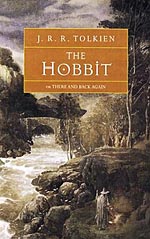 When you think of WWI fantasy, especially in the young adult genre, you might think of steampunk sci-fi, like Scott Westerfeld‘s Leviathan series. I, on the other hand, think of The Hobbit. Tolkien wrote this classic in 1937, well after the Great War, but much of it came from his experience in the trenches. The book begins with Bilbo puttering around Bag End in the idyllic setting of the Shire, not unlike Tolkien’s own neighborhood in north Oxford. He is then, quite literally drafted by Gandalf to join a platoon of dwarves and sent to the front of a war to witness the Desolation of Smaug. It’s a story similar to Tolkien’s own experience in the Great War, where he was struck with trench fever in 1916. It was while recovering from the disease that he began writing The Book of Lost Tales, which would establish the history and continuity of Middle-Earth.
When you think of WWI fantasy, especially in the young adult genre, you might think of steampunk sci-fi, like Scott Westerfeld‘s Leviathan series. I, on the other hand, think of The Hobbit. Tolkien wrote this classic in 1937, well after the Great War, but much of it came from his experience in the trenches. The book begins with Bilbo puttering around Bag End in the idyllic setting of the Shire, not unlike Tolkien’s own neighborhood in north Oxford. He is then, quite literally drafted by Gandalf to join a platoon of dwarves and sent to the front of a war to witness the Desolation of Smaug. It’s a story similar to Tolkien’s own experience in the Great War, where he was struck with trench fever in 1916. It was while recovering from the disease that he began writing The Book of Lost Tales, which would establish the history and continuity of Middle-Earth.
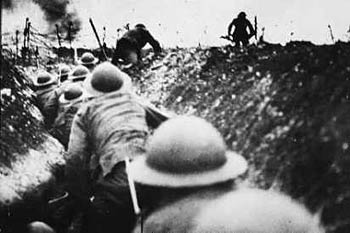 At first glance, trench warfare might not seem like a suitable inspiration for a children’s book. Perhaps that is why it took so long for The Hobbit to be written. Although set in Middle-Earth, Bilbo’s story wasn’t penned until the 1930s, when, upon spying a blank sheet of paper Tolkien impishly wrote "In a hole in the ground, there lived a hobbit." It might have been terror and illness that inspired Middle-Earth for the author, but the first published account of that world would be more childlike and innocent.
At first glance, trench warfare might not seem like a suitable inspiration for a children’s book. Perhaps that is why it took so long for The Hobbit to be written. Although set in Middle-Earth, Bilbo’s story wasn’t penned until the 1930s, when, upon spying a blank sheet of paper Tolkien impishly wrote "In a hole in the ground, there lived a hobbit." It might have been terror and illness that inspired Middle-Earth for the author, but the first published account of that world would be more childlike and innocent.
In this sense, one might say that the story of Tolkien’s world is backwards. The Book of Lost Tales was the first thing Tolkien put to paper, but it wouldn’t be published until 1992, long after the author’s death. We, the reader, would begin not in desolation, but in delight. That’s how it started for me, of course. The Hobbit was one of the first YA books I ever read (after The Chronicles of Narnia by C.S. Lewis, and Ursula K. Le Guin‘s Earthsea Trilogy). It was a great transition for me, because it was really the only YA book set in Middle-Earth. Of course, I read the entire Lord of the Rings series as a teenager, but it was really intended for adults. By the time I graduated to The Silmarillion, I was out of my element. At 14, I barely understood the mature themes and deep mythological references.
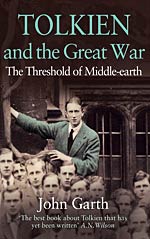 The Hobbit, then, is not just a children’s or a YA book. It’s an introduction to wider world that continues to expand in depth and complexity as its reader matures. It is, as the best of fantasy ought to be, the first in a series of books that taps into human tradition and reminds us of what we once believed…and might believe again. What does all of that have to do with a fruitless war that is universally regarded as a dark chapter in human history? Like many works of the Lost Generation, it is a reaction to the event — one that recognizes the inevitability of conflict and human misery. Unlike many of those works, however, there is more hope than mourning. Bilbo returns from his war changed, possibly less innocent, but not truly lost.
The Hobbit, then, is not just a children’s or a YA book. It’s an introduction to wider world that continues to expand in depth and complexity as its reader matures. It is, as the best of fantasy ought to be, the first in a series of books that taps into human tradition and reminds us of what we once believed…and might believe again. What does all of that have to do with a fruitless war that is universally regarded as a dark chapter in human history? Like many works of the Lost Generation, it is a reaction to the event — one that recognizes the inevitability of conflict and human misery. Unlike many of those works, however, there is more hope than mourning. Bilbo returns from his war changed, possibly less innocent, but not truly lost.
There is a reason an entire genre was inspired (perhaps overly so) by this new kind of young adult fantasy, and, as great as our current crop of writers are, I’m not entirely convinced that they have topped this classic.
YA Genre Fiction Month: The Chronicles of Narnia
It all began with a wardrobe. Being your average, American, suburban child, of course I had no idea what a wardrobe was. All I knew was that it was far larger on the inside than the outside, large enough to house a fairy kingdom of gods and talking beasts, of hidden kings and snowed in lampposts.
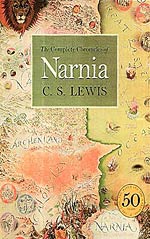 The stories of C.S. Lewis’s Narnia series are in a certain sense pretty standard fare: a child living in unappealing and banal circumstances finds a doorway to a magical realm, has many adventures in said realm, then returns to find that life in the normal world is much enriched by the experience. It would be hard to find a more prototypical plot than this. Even so, Lewis’s series manages to stand out in a crowd of similar stories, and I suspect this is because he evoked a world that is lost, but which was very much real: the Middle Ages.
The stories of C.S. Lewis’s Narnia series are in a certain sense pretty standard fare: a child living in unappealing and banal circumstances finds a doorway to a magical realm, has many adventures in said realm, then returns to find that life in the normal world is much enriched by the experience. It would be hard to find a more prototypical plot than this. Even so, Lewis’s series manages to stand out in a crowd of similar stories, and I suspect this is because he evoked a world that is lost, but which was very much real: the Middle Ages.
Being a scholar of Medieval literature by trade, Lewis was well-suited to the task of reviving a dead age. His book The Discarded Image is an introductory exploration of the way Medieval man viewed the world, which was as a subtly complex and interconnected system that hummed in a sort of clockwork harmony. It was a world rife with symbols and archetypes, with God at its source, and all his creatures working either against or with this source.
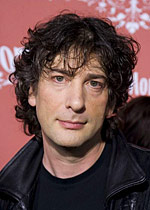 So of course modern fantasy writers hate it. Neil Gaiman and Philip Pullman are the most recent detractors, vilifying Lewis’s books as being nothing more than religious propaganda. They are not entirely wrong. Lewis was hardly ashamed of his conversion to Anglicanism, publishing many books and essays on both his conversion and the theology of his new religion. When it came to writing fiction, Anglican-Protestant theology was a motivating force, as well. His Cosmic Trilogy is clearly theological in places, especially in Perelandra, which served as a “scientifiction” reimagining of Paradise Lost on another planet. The Narnia series is even more blatantly Christian in as much as it depicts Aslan, a talking lion who is not simply a Christ-figure or an allegory, but Christ himself.
So of course modern fantasy writers hate it. Neil Gaiman and Philip Pullman are the most recent detractors, vilifying Lewis’s books as being nothing more than religious propaganda. They are not entirely wrong. Lewis was hardly ashamed of his conversion to Anglicanism, publishing many books and essays on both his conversion and the theology of his new religion. When it came to writing fiction, Anglican-Protestant theology was a motivating force, as well. His Cosmic Trilogy is clearly theological in places, especially in Perelandra, which served as a “scientifiction” reimagining of Paradise Lost on another planet. The Narnia series is even more blatantly Christian in as much as it depicts Aslan, a talking lion who is not simply a Christ-figure or an allegory, but Christ himself.
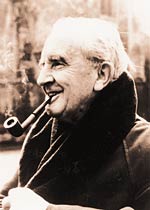 So of course Tolkien hated it. Lewis’s Catholic friend and fellow writer could only accept Lewis’s books as allegorical works because of the theological problems that would arise with a literal intention. Lewis himself published an introductory study to Medieval allegory, The Allegory of Love, and he knew his own intentions well enough to know that he was not writing an allegory. The structure of the series, and many of the characters therein, are densely symbolic (cf. Planet Narnia by Michael Ward), as is Aslan’s leonine appearance, but the character himself is controversially straightforward.
So of course Tolkien hated it. Lewis’s Catholic friend and fellow writer could only accept Lewis’s books as allegorical works because of the theological problems that would arise with a literal intention. Lewis himself published an introductory study to Medieval allegory, The Allegory of Love, and he knew his own intentions well enough to know that he was not writing an allegory. The structure of the series, and many of the characters therein, are densely symbolic (cf. Planet Narnia by Michael Ward), as is Aslan’s leonine appearance, but the character himself is controversially straightforward.
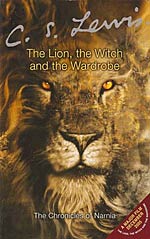 Oddly enough, none of these controversies have diminished the series’ popularity. Children and young adults everywhere continue to read them, finding inside something too often lacking in today’s literature for young people: a sense of wonder. From Mr. Tumnus’s cozy home to the Green Lady’s cavern, from the deserts of Calormen to the edge of Aslan’s country, Narnia is an unceasing flow of delightful places and events. The popularity of the recent Narnia films proves that the series has legs in the modern world. Lewis would probably be the first to insist that one should read for delight rather than duty, and even his popular detractors can’t make the books unpleasurable to read, except for unhappy adults who insist on writing and reading propaganda of the opposing sort. I think we can expect Narnia to stick around for a long time.
Oddly enough, none of these controversies have diminished the series’ popularity. Children and young adults everywhere continue to read them, finding inside something too often lacking in today’s literature for young people: a sense of wonder. From Mr. Tumnus’s cozy home to the Green Lady’s cavern, from the deserts of Calormen to the edge of Aslan’s country, Narnia is an unceasing flow of delightful places and events. The popularity of the recent Narnia films proves that the series has legs in the modern world. Lewis would probably be the first to insist that one should read for delight rather than duty, and even his popular detractors can’t make the books unpleasurable to read, except for unhappy adults who insist on writing and reading propaganda of the opposing sort. I think we can expect Narnia to stick around for a long time.
Philip K. Dickathon: Divine Invasions
Guest Blogger and WWEnd Member, Charles Dee Mitchell, has contributed a great many book reviews to WWEnd and we’ve invited him to contribute to our blog. This is the latest in Dee’s series of Philip K. Dick reviews that he started on his blog www.potatoweather.blogspot.com. We’ll be posting one every week until he runs out of reviews or gets tired of Philip K. Dick books.
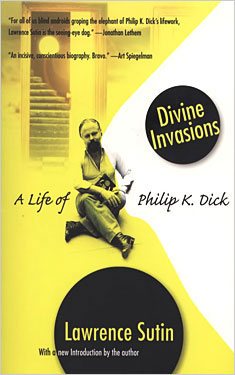 Divine Invasions: A Life of Philip K. Dick
Divine Invasions: A Life of Philip K. Dick
by Lawrence Sutin
My rating: 4 of 5 stars
Answer the following True or False questions about the life of Philip K. Dick:
1) PKD’s twin sister, Jane, died in the first months of her life from malnutrition and poor home care.
2) Later in life, PDK liked to imagine that his sister was living and a lesbian.
3) In high school, PKD’s agoraphobia was at times so bad that he could not go to public events such as concerts. Later he was comfortable in only one Chinese restaurant that had very high sides to its booths.
4) PKD was on amphetamines from the mid 1950’s until around 1972. Some were prescribed, but as the drug scene took off in the 1960’s, he also bought speed off the street.
5) When he was a young man, his mother told him that if he left home he would become a homosexual.
6) PKD’s first wife was also the first woman he had sex with. The marriage lasted six months and Jeanette, the wife, said in court that Phil’s record playing kept her up at night.
7) PKD was married five times, towards the end to women who were barely half his age.
8) Between 1953 and 1957, PKD wrote 14 novels. Between 1963 and 1964 he wrote 11.
9) PKD wrote The Three Stigmata of Palmer Eldritch while tripping on acid.
10) PKD stole pills from his mother and blamed her for not keeping them under lock and key.
11) While trying to live in Canada, PKD felt a mental collapse coming on and pretended to be a heroin addict to get into the only treatment program he could find. He did not like the people he met there.
12) When PKD’s house was broken into, ransacked, and burgled the police were not able to solve the case. They considered PKD to be their most likely suspect.
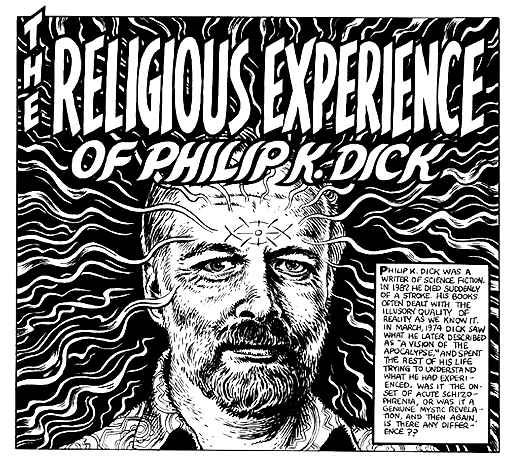 13) When PKD and his wife were investigated by the FBI, his wife fixed dinner for the agents and one agent taught PKD how to drive.
13) When PKD and his wife were investigated by the FBI, his wife fixed dinner for the agents and one agent taught PKD how to drive.
14) In February, 1974, PKD had an impacted wisdom tooth removed and sodium pentathol was used. Later that day, a girl from the drugstore who was delivering Darvon wore an icthus, the Christian fish symbol. When it caught the light, and PKD stared at it, he realized for the first time that he was an immortal being. For the remainder of his life he had visions of the divine and conversations with a divine presence he named VALIS,
15) PKD’s spiritual visions, and many of his other character traits, are common symptoms of temporal lobe epilepsy.
Only number (9) is false. According to his biographer Lawrence Sutin, all the rest are true.
The Locus Young Adult Award
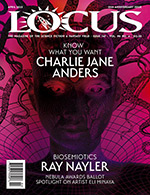 As part of our new YA Genre Fiction Month we’ve just added the Locus Young Adult Award for best novel to the site. The award was first issued in 2003 so it has not been around a long time like some of our other awards but we feel it’s a great place to start our expanded coverage.
As part of our new YA Genre Fiction Month we’ve just added the Locus Young Adult Award for best novel to the site. The award was first issued in 2003 so it has not been around a long time like some of our other awards but we feel it’s a great place to start our expanded coverage.
If you’re a fan of YA this is the award for you but more than that it’s a great resource for us parents trying to introduce our children to genre fiction. Tolkien and Lewis, and the other classics we know and love, can only take us so far. If you’re at all like me you may not know where to begin with the more recent work and oftentimes unfamiliar authors. Plus, with the holiday season rolling ’round the corner, this list of great books might come in handy when you go shopping. Christmas without books is just not Christmas – even if my kids disagree.
So what do you think of this award? Have you read many of these books? Any that you would recommend?
Young Adult Genre Fiction Month
It’s a new month, and time for a new theme here at Worlds Without End! During the month of October we filled in a major lacuna by including Horror as a major genre category, and by adding relevant award and book lists that show off the best of the genre. This November we’re adding and promoting a similarly popular group of fiction, which can’t quite be categorized as a genre or subgenre: Young Adult Fiction. Our more attentive members have probably noticed the addition of many Young Adult novels to the site over the last week. Doing so completes our collection of nominees for the Young Adult category of the Locus Award, and we will be publishing the full list for this award to the site soon.
To supplement the upcoming award and book lists, we will be posting Young-Adult themed book reviews and articles to the blog during the month of November. Young Adult literature stands in that precarious brink between childhood and adulthood, and the books we read during those few years often keep a special place in our memory for the rest of our lives. The books we will be featuring are likely to hold that very place for the next generation.
Few people realize (or remember) just how many Young Adult books are also examples of genre fiction. Science Fiction, Fantasy, and Horror are all well-represented in Young Adult fiction, and we at Worlds Without End wish to celebrate this representation all month, so we are dubbing November “Young Adult Genre Fiction Month.” Check back regularly for new updates and articles!



















 Full Details
Full Details
